2023 CADILLAC LYRIC brake
[x] Cancel search: brakePage 302 of 424
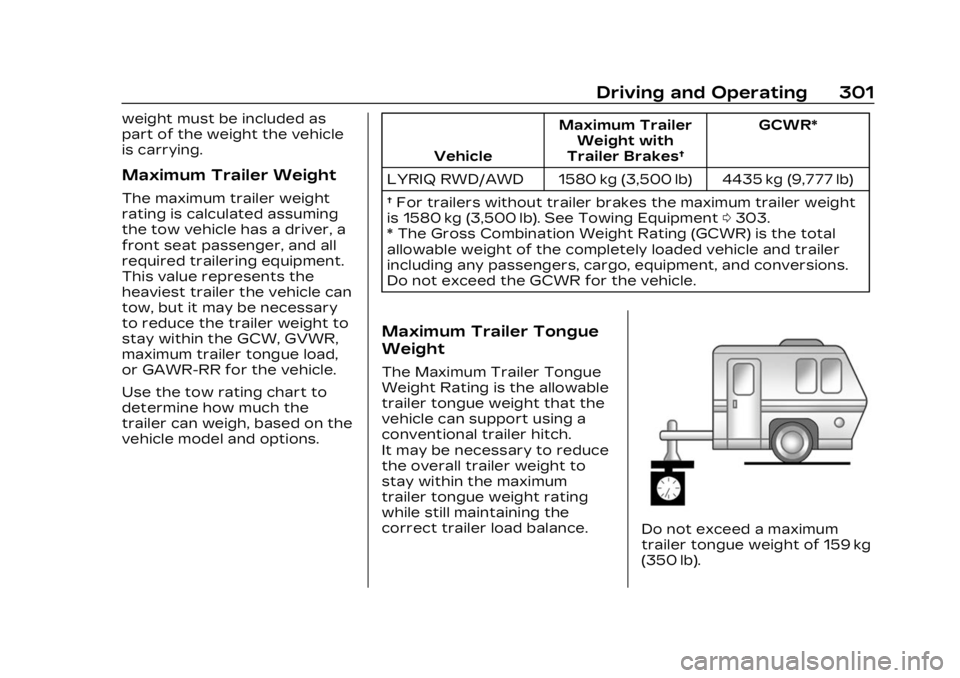
Cadillac Lyriq Owner Manual (GMNA-Localizing-U.S./Canada-15644413) -
2023 - CRC - 2/23/22
Driving and Operating 301
weight must be included as
part of the weight the vehicle
is carrying.
Maximum Trailer Weight
The maximum trailer weight
rating is calculated assuming
the tow vehicle has a driver, a
front seat passenger, and all
required trailering equipment.
This value represents the
heaviest trailer the vehicle can
tow, but it may be necessary
to reduce the trailer weight to
stay within the GCW, GVWR,
maximum trailer tongue load,
or GAWR-RR for the vehicle.
Use the tow rating chart to
determine how much the
trailer can weigh, based on the
vehicle model and options.Vehicle
Maximum Trailer
Weight with
Trailer Brakes† GCWR*
LYRIQ RWD/AWD 1580 kg (3,500 lb) 4435 kg (9,777 lb)
† For trailers without trailer brakes the maximum trailer weight
is 1580 kg (3,500 lb). See Towing Equipment 0303.
* The Gross Combination Weight Rating (GCWR) is the total
allowable weight of the completely loaded vehicle and trailer
including any passengers, cargo, equipment, and conversions.
Do not exceed the GCWR for the vehicle.
Maximum Trailer Tongue
Weight
The Maximum Trailer Tongue
Weight Rating is the allowable
trailer tongue weight that the
vehicle can support using a
conventional trailer hitch.
It may be necessary to reduce
the overall trailer weight to
stay within the maximum
trailer tongue weight rating
while still maintaining the
correct trailer load balance.
Do not exceed a maximum
trailer tongue weight of 159 kg
(350 lb).
Page 305 of 424
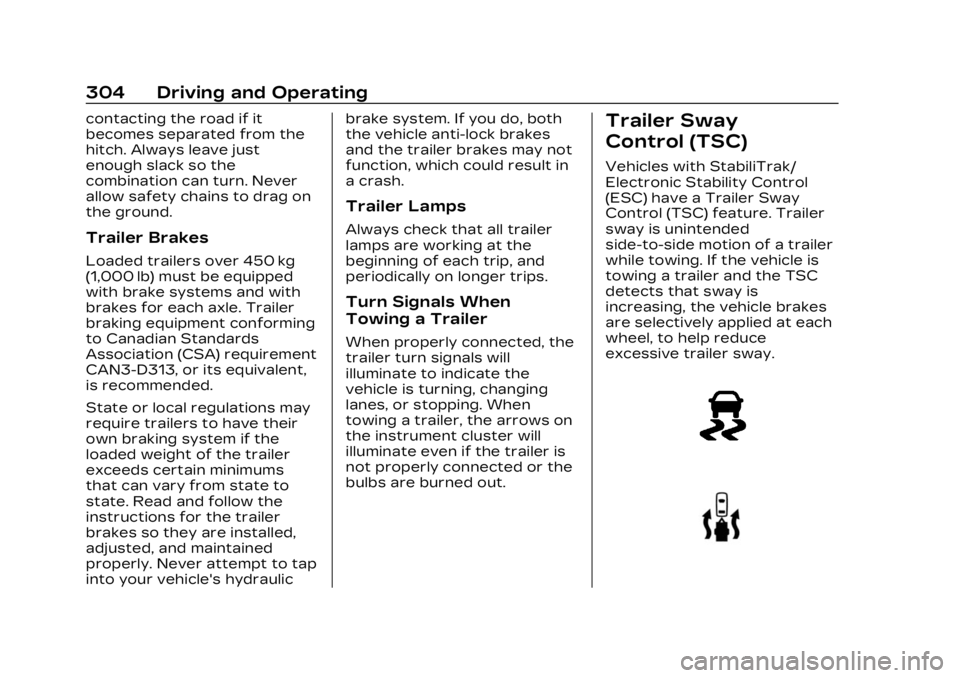
Cadillac Lyriq Owner Manual (GMNA-Localizing-U.S./Canada-15644413) -
2023 - CRC - 2/23/22
304 Driving and Operating
contacting the road if it
becomes separated from the
hitch. Always leave just
enough slack so the
combination can turn. Never
allow safety chains to drag on
the ground.
Trailer Brakes
Loaded trailers over 450 kg
(1,000 lb) must be equipped
with brake systems and with
brakes for each axle. Trailer
braking equipment conforming
to Canadian Standards
Association (CSA) requirement
CAN3-D313, or its equivalent,
is recommended.
State or local regulations may
require trailers to have their
own braking system if the
loaded weight of the trailer
exceeds certain minimums
that can vary from state to
state. Read and follow the
instructions for the trailer
brakes so they are installed,
adjusted, and maintained
properly. Never attempt to tap
into your vehicle's hydraulicbrake system. If you do, both
the vehicle anti-lock brakes
and the trailer brakes may not
function, which could result in
a crash.
Trailer Lamps
Always check that all trailer
lamps are working at the
beginning of each trip, and
periodically on longer trips.
Turn Signals When
Towing a Trailer
When properly connected, the
trailer turn signals will
illuminate to indicate the
vehicle is turning, changing
lanes, or stopping. When
towing a trailer, the arrows on
the instrument cluster will
illuminate even if the trailer is
not properly connected or the
bulbs are burned out.
Trailer Sway
Control (TSC)
Vehicles with StabiliTrak/
Electronic Stability Control
(ESC) have a Trailer Sway
Control (TSC) feature. Trailer
sway is unintended
side-to-side motion of a trailer
while towing. If the vehicle is
towing a trailer and the TSC
detects that sway is
increasing, the vehicle brakes
are selectively applied at each
wheel, to help reduce
excessive trailer sway.
Page 308 of 424

Cadillac Lyriq Owner Manual (GMNA-Localizing-U.S./Canada-15644413) -
2023 - CRC - 2/23/22
Vehicle Care 307
Vehicle Care
General Information
General Information . . . . . . 308
California PerchlorateMaterials
Requirements . . . . . . . . . . . . . 308
Accessories and Modifications . . . . . . . . . . . . . 308
Vehicle Checks
Doing Your OwnService Work . . . . . . . . . . . . . 309
Hood . . . . . . . . . . . . . . . . . . . . . . . . . . . 310
Underhood Compartment Overview . . . . . . . . . . . . . . . . . . . . 312
Cooling System . . . . . . . . . . . . . 313
Washer Fluid . . . . . . . . . . . . . . . . 314
Brakes . . . . . . . . . . . . . . . . . . . . . . . . . 315
Brake Fluid . . . . . . . . . . . . . . . . . . . 316
Battery - North America . . . . . . . . . . . . . . . . . . . . . . 317
Park Brake and P (Park) Mechanism Check . . . . . . . 320
Wiper Blade Replacement . . . . . . . . . . . . . . 320
Windshield Replacement . . . . . . . . . . . . . . . 321
Gas Strut(s) . . . . . . . . . . . . . . . . . . 321
Headlamp Aiming
Front Headlamp Aiming . . . . . . . . . . . . . . . . . . . . . . . 322
Bulb Replacement
Bulb Replacement . . . . . . . . . 323
LED Lighting . . . . . . . . . . . . . . . . 323
Electrical System
High Voltage Devices andWiring . . . . . . . . . . . . . . . . . . . . . . . 323
Electrical System Overload . . . . . . . . . . . . . . . . . . . . 323
Fuses and Circuit Breakers . . . . . . . . . . . . . . . . . . . . 325
Underhood Compartment Fuse Block . . . . . . . . . . . . . . . . . 326
Instrument Panel Fuse Block . . . . . . . . . . . . . . . . . . . . . . . . . 331
Wheels and Tires
Tires . . . . . . . . . . . . . . . . . . . . . . . . . . . 334
All-Season Tires . . . . . . . . . . . 335
Winter Tires . . . . . . . . . . . . . . . . 336
Self-Sealing Tires . . . . . . . . . 336
Low-Profile Tires . . . . . . . . . . 337
Tire Sidewall Labeling . . . . 337
Tire Designations . . . . . . . . . . 338
Tire Terminology andDefinitions . . . . . . . . . . . . . . . . . 339
Tire Pressure . . . . . . . . . . . . . . . 342 Tire Pressure Monitor
System . . . . . . . . . . . . . . . . . . . . . . 343
Tire Pressure Monitor Operation . . . . . . . . . . . . . . . . . . 344
Tire Inspection . . . . . . . . . . . . . 347
Tire Rotation . . . . . . . . . . . . . . . 348
When It Is Time for New
Tires . . . . . . . . . . . . . . . . . . . . . . . . . 349
Buying New Tires . . . . . . . . . 350
Different Size Tires and Wheels . . . . . . . . . . . . . . . . . . . . . . 352
Uniform Tire Quality Grading . . . . . . . . . . . . . . . . . . . . . 352
Wheel Alignment and Tire Balance . . . . . . . . . . . . . . . 354
Wheel Replacement . . . . . . 354
Tire Chains . . . . . . . . . . . . . . . . . . 355
If a Tire Goes Flat . . . . . . . . . 355
Jump Starting
Jump Starting - North America . . . . . . . . . . . . . . . . . . . . . 356
Towing the Vehicle
Transporting a DisabledVehicle . . . . . . . . . . . . . . . . . . . . . . 359
Recreational Vehicle Towing . . . . . . . . . . . . . . . . . . . . . . 362
Page 309 of 424

Cadillac Lyriq Owner Manual (GMNA-Localizing-U.S./Canada-15644413) -
2023 - CRC - 2/23/22
308 Vehicle Care
Appearance Care
Exterior Care . . . . . . . . . . . . . . . 364
Interior Care . . . . . . . . . . . . . . . . 369
Floor Mats . . . . . . . . . . . . . . . . . . . 373General
Information
For service and parts needs,
visit your dealer. You will
receive genuine GM parts and
GM-trained and supported
service people.
Genuine GM parts have one of
these marks:
California Perchlorate
Materials
Requirements
Certain types of automotive
applications, such as airbag
initiators, seat belt
pretensioners, and lithium
batteries contained in
electronic keys, may contain
perchlorate materials.
Perchlorate Material–special
handling may apply. See
www.dtsc.ca.gov/
hazardouswaste/perchlorate.
Accessories and
Modifications
Adding non-dealer accessories
or making modifications to the
vehicle can affect vehicle
performance and safety,
including such things as
airbags, braking, stability, ride
and handling, emissions
systems, aerodynamics,
durability, Driver Assistance
Systems, and electronic
systems like antilock brakes,
Page 311 of 424
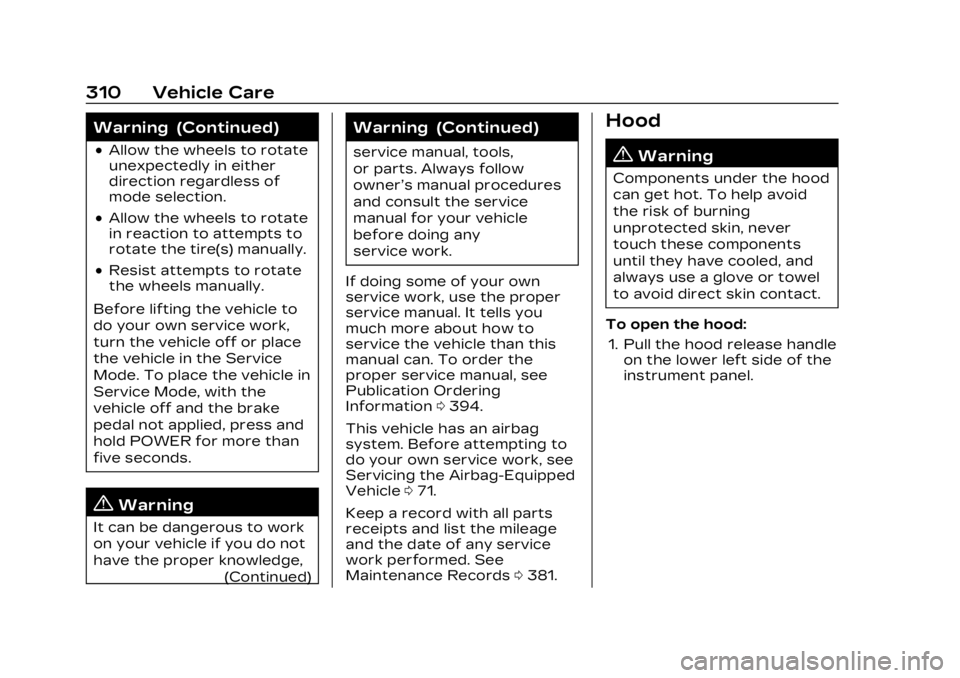
Cadillac Lyriq Owner Manual (GMNA-Localizing-U.S./Canada-15644413) -
2023 - CRC - 2/23/22
310 Vehicle Care
Warning (Continued)
.Allow the wheels to rotate
unexpectedly in either
direction regardless of
mode selection.
.Allow the wheels to rotate
in reaction to attempts to
rotate the tire(s) manually.
.Resist attempts to rotate
the wheels manually.
Before lifting the vehicle to
do your own service work,
turn the vehicle off or place
the vehicle in the Service
Mode. To place the vehicle in
Service Mode, with the
vehicle off and the brake
pedal not applied, press and
hold POWER for more than
five seconds.
{Warning
It can be dangerous to work
on your vehicle if you do not
have the proper knowledge, (Continued)
Warning (Continued)
service manual, tools,
or parts. Always follow
owner’s manual procedures
and consult the service
manual for your vehicle
before doing any
service work.
If doing some of your own
service work, use the proper
service manual. It tells you
much more about how to
service the vehicle than this
manual can. To order the
proper service manual, see
Publication Ordering
Information 0394.
This vehicle has an airbag
system. Before attempting to
do your own service work, see
Servicing the Airbag-Equipped
Vehicle 071.
Keep a record with all parts
receipts and list the mileage
and the date of any service
work performed. See
Maintenance Records 0381.
Hood
{Warning
Components under the hood
can get hot. To help avoid
the risk of burning
unprotected skin, never
touch these components
until they have cooled, and
always use a glove or towel
to avoid direct skin contact.
To open the hood: 1. Pull the hood release handle on the lower left side of the
instrument panel.
Page 312 of 424

Cadillac Lyriq Owner Manual (GMNA-Localizing-U.S./Canada-15644413) -
2023 - CRC - 2/23/22
Vehicle Care 311
2. Release the handle, thenpull the handle again to fully
open the hood.
3. Go to the front of the vehicle and lift the
hood open. To close the hood:
1. Be sure all filler caps are on properly, and all tools are
removed.
2. Lower the hood down until the strut system is no
longer holding up the hood.
3. Allow the hood to fall. Check to make sure the hood is
latched completely. Repeat
this process with additional
force if necessary.
4. If the hood does not latch, a message will display on the
Driver Information Center
(DIC) indicating the vehicle
will not shift out of (P) Park.
To override this function,
press and hold the brake
pedal until override
completion message is
displayed on DIC.
{Warning
Do not drive the vehicle if
the hood is not latched
completely. The hood could
open fully, block your vision,
and cause a crash. You or
others could be injured.
Always close the hood
completely before driving.
Page 314 of 424
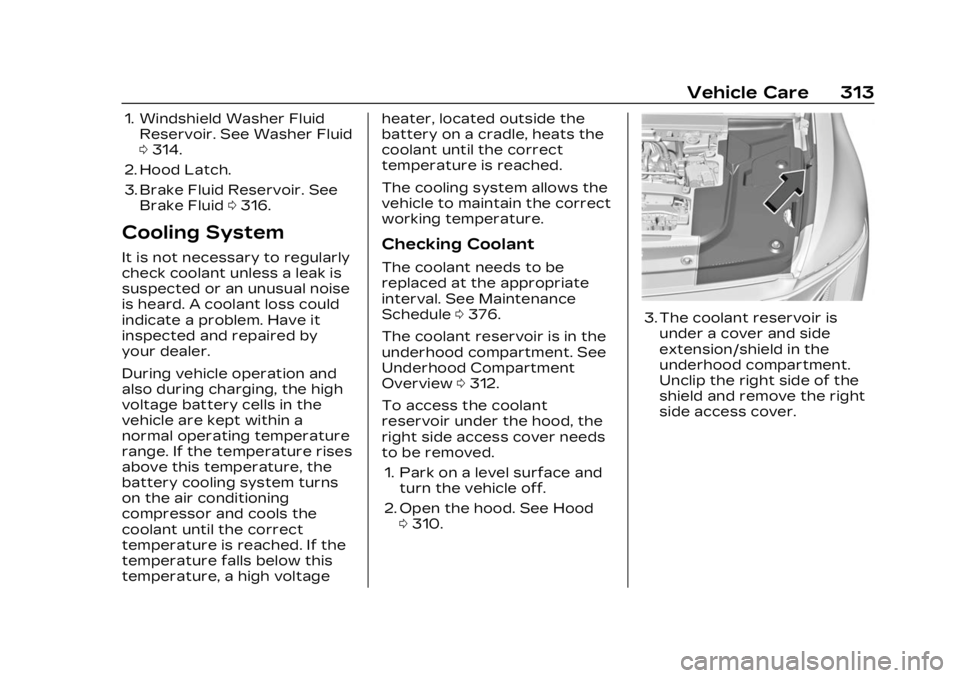
Cadillac Lyriq Owner Manual (GMNA-Localizing-U.S./Canada-15644413) -
2023 - CRC - 2/23/22
Vehicle Care 313
1. Windshield Washer FluidReservoir. See Washer Fluid
0314.
2. Hood Latch.
3. Brake Fluid Reservoir. See Brake Fluid 0316.
Cooling System
It is not necessary to regularly
check coolant unless a leak is
suspected or an unusual noise
is heard. A coolant loss could
indicate a problem. Have it
inspected and repaired by
your dealer.
During vehicle operation and
also during charging, the high
voltage battery cells in the
vehicle are kept within a
normal operating temperature
range. If the temperature rises
above this temperature, the
battery cooling system turns
on the air conditioning
compressor and cools the
coolant until the correct
temperature is reached. If the
temperature falls below this
temperature, a high voltage heater, located outside the
battery on a cradle, heats the
coolant until the correct
temperature is reached.
The cooling system allows the
vehicle to maintain the correct
working temperature.Checking Coolant
The coolant needs to be
replaced at the appropriate
interval. See Maintenance
Schedule
0376.
The coolant reservoir is in the
underhood compartment. See
Underhood Compartment
Overview 0312.
To access the coolant
reservoir under the hood, the
right side access cover needs
to be removed. 1. Park on a level surface and turn the vehicle off.
2. Open the hood. See Hood 0310.
3. The coolant reservoir is
under a cover and side
extension/shield in the
underhood compartment.
Unclip the right side of the
shield and remove the right
side access cover.
Page 316 of 424
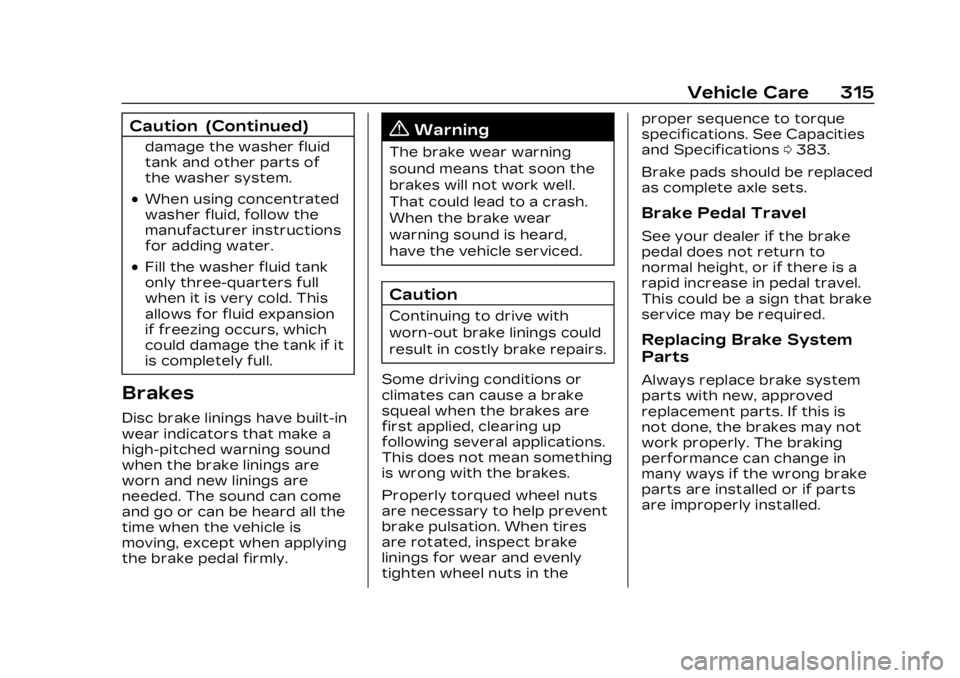
Cadillac Lyriq Owner Manual (GMNA-Localizing-U.S./Canada-15644413) -
2023 - CRC - 2/23/22
Vehicle Care 315
Caution (Continued)
damage the washer fluid
tank and other parts of
the washer system.
.When using concentrated
washer fluid, follow the
manufacturer instructions
for adding water.
.Fill the washer fluid tank
only three-quarters full
when it is very cold. This
allows for fluid expansion
if freezing occurs, which
could damage the tank if it
is completely full.
Brakes
Disc brake linings have built-in
wear indicators that make a
high-pitched warning sound
when the brake linings are
worn and new linings are
needed. The sound can come
and go or can be heard all the
time when the vehicle is
moving, except when applying
the brake pedal firmly.
{Warning
The brake wear warning
sound means that soon the
brakes will not work well.
That could lead to a crash.
When the brake wear
warning sound is heard,
have the vehicle serviced.
Caution
Continuing to drive with
worn-out brake linings could
result in costly brake repairs.
Some driving conditions or
climates can cause a brake
squeal when the brakes are
first applied, clearing up
following several applications.
This does not mean something
is wrong with the brakes.
Properly torqued wheel nuts
are necessary to help prevent
brake pulsation. When tires
are rotated, inspect brake
linings for wear and evenly
tighten wheel nuts in the proper sequence to torque
specifications. See Capacities
and Specifications
0383.
Brake pads should be replaced
as complete axle sets.
Brake Pedal Travel
See your dealer if the brake
pedal does not return to
normal height, or if there is a
rapid increase in pedal travel.
This could be a sign that brake
service may be required.
Replacing Brake System
Parts
Always replace brake system
parts with new, approved
replacement parts. If this is
not done, the brakes may not
work properly. The braking
performance can change in
many ways if the wrong brake
parts are installed or if parts
are improperly installed.